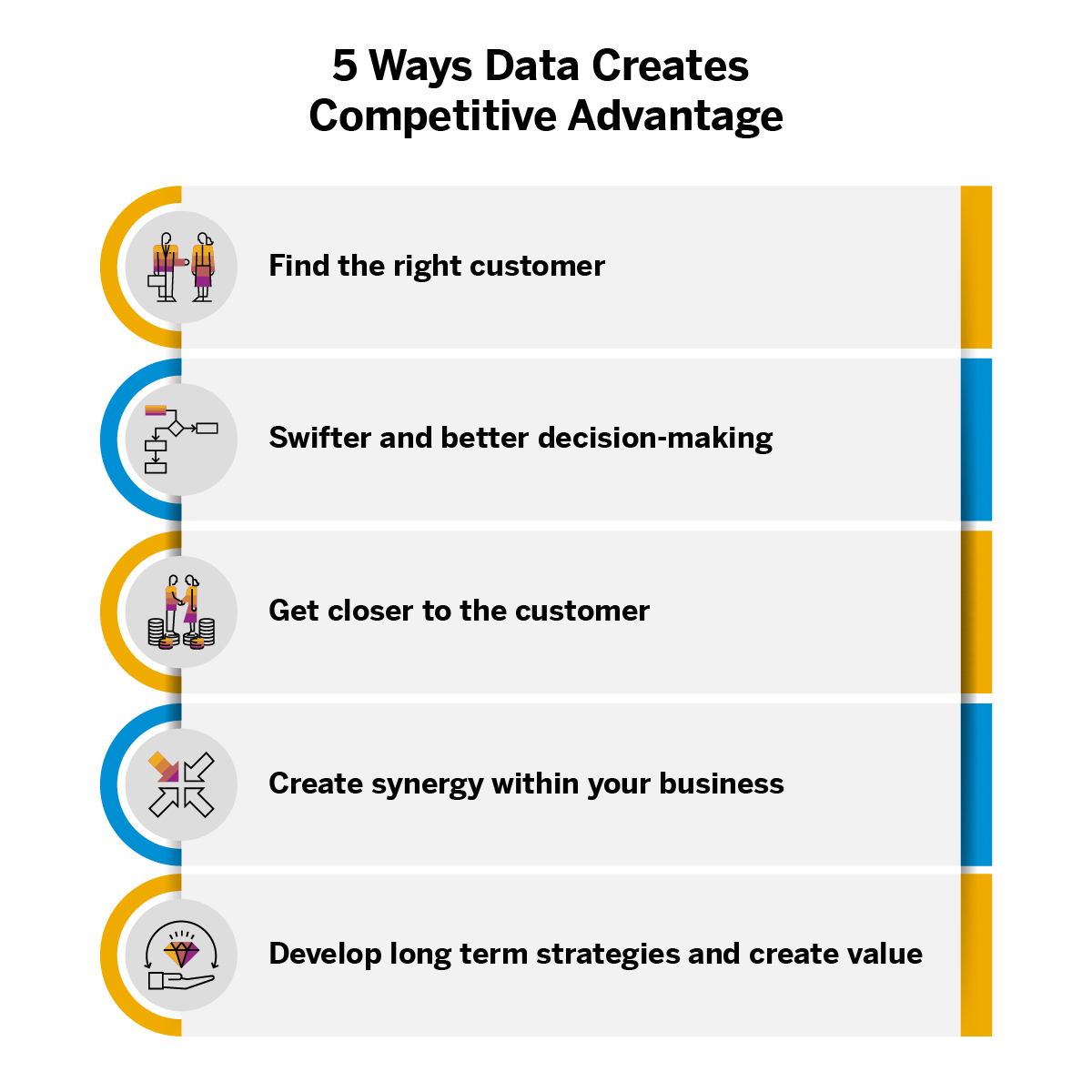‘Data is the new oil’- a British mathematician said this often-repeated phrase back in 2006. The comparison is not far-fetched, as data analytics has become one of the most sought after and competed for assets in the world. Massive amounts of data are collected by different businesses every second. From customer purchasing habits, browsing times on a website or at a shelf, and product usage habits to location data of a customer, product feedback and scrolling patterns, data is generated and collected from every action we take. And this data keeps growing. In fact, 90% of digital data in the world has been created in the last couple of years alone, and this will only increase. However, data alone cannot be of use to any organization.

Data and Analytics
All the massive data gathered by organizations requires analysis. Traditional methods of computing did not allow for quick analysis of such large amounts of data. However, with the advent of new technologies such as cloud computing, organizations can now process data quickly. Data analytics has also become more meaningful with the help of these technologies, and vast amounts of data can now be made more sense of.
With products and services that come enabled with internet connectivity, various kinds of data can be collected and instantly analyzed. This data from the customers includes:
- purchasing and search behavior
- personal preferences and details
- methods of communication
- social media usage patterns
- location information
Once all this data has been analyzed by machine-learning algorithms, the services offered by an organization can be adjusted to suit individual needs. The services offered to the customers can thus be tailor-made.
It is thus the analytical results of data that can be used by an organization for different purposes. Data analytics are, therefore, the digital processes that use data and insights from different channels. This data is ultimately used to generate value for the customers in the data-rich business environment of today.
Therefore, like oil, data can be refined through analytics and turned into a highly valuable asset. And this has never been as true as it is today. Data has become one of the most important commodities for businesses worldwide. Organizations can use the data to gain a competitive edge in their business by understanding the environment in which they function.
Organizations around the world are increasingly recognizing the importance of data. For example, 81 percent of respondents in China believed that data analytics is either extremely important or very important to sustain a competitive business, according to a survey conducted last year. In North America, 34 percent had a similar opinion.

Innovation driven by data has been predicted to be one of the most significant ways that would help to improve social welfare and hasten economic growth in the 21st century. Data gathered through greater interactions between business and customer is helping to bring together the two. This is leading to more accessible and customer-friendly business environments.
In another survey conducted in 2020, half of the executives working in the global travel and hospitality industry believed that customer data analytics was crucial to the success of their companies and helped in achieving a competitive advantage in the business. While most of the executives believed that data analytics was important to varying degrees, only one percent of the respondents believed that customer data analytics was not important at all. These trends show how data operations and analytics are becoming an essential determinant in the competition in businesses.
The high value that is being placed on data also reflects in the increasing investments in data analytics. Two years ago, the global market for big data and business analytics was valued at $168.8 billion and by end-2021 it’s expected to grow to $ 215.7 billion. More than half of the spending in big data analytics is likely to go towards services. IT services are projected to make up around $85 billion. Business services will account for the rest.
So how can data help your business to gain a competitive advantage? We give you 5 ways in which this can be done:
- Data helps you find the right customer
Many businesses waste resources by targeting the wrong group of people. Basically, sales teams try to woo customers who do not require their services. This leads to wastage of resources and time. Finding the right customer for your business is therefore important. Data and analytics can help your business by attracting the right kind of customer.
The right customers – who need your solution or service –help your business stay profitable and help by providing large-scale data resources. This data forms the raw material for deriving greater insights through data analytics. This data can include the user’s behavior, preferences and shopping habits. This user-generated content, created by the customers themselves, then becomes a repository for the business to glean useful information from. It can ultimately help the business in multiple ways, by allowing it to
- design the right kind of marketing campaigns
- target the right group of people
- deliver their service through the right kind of channels
Personalized data resource allocation mechanisms can also allow a business to understand the needs of the customer better. It also reduces the effort required from a customer to have a service delivered to them through predictive and proactive executive frameworks. Such frameworks can be put in place only through data and analytics.
- Swifter and better decision-making
Data can be a massive tool for any business if it is used right. One of the most important advantages that it equips an organization with is better and quicker decision making. This is achieved in multiple ways. One of them is by helping to deliver the right data to the right people at the right time. For example, relevant data from your feedback and customer service department can be quickly diverted to the design and production section to convey the faults in a product. After analyzing customer preferences, a product can then be designed which is more suited to the customer needs. All this requires the right information to reach the right people within your organization. Data analytics help to organize all this information for dispatching to the relevant personnel.
Another way that data helps in decision-making is by helping your business to understand what the customer is looking for. Businesses gather a lot of data from the customers and the markets. This data, when analyzed properly, can help businesses to get a sense of the customers’ minds. Data-driven analytics do this by helping your business to understand just exactly what your customers need, when they need it, and how to deliver it best. This data can also help the business to understand the kind of product and service they need to supply, and how to market the product. This data can also be used for tracking current developments and for forecasting the future. All these help the business to make better decisions in a shorter time.
Data-driven analytics can also help struggling businesses to understand the reasons for slow or stunted growth. Once the problem is identified, data can also help the business find the best remedial measures to recover growth.
- Helps you get closer to the customer
Businesses are increasingly moving towards platform economies. These are business and economic projects and activities that are carried out digitally and facilitated by platforms. Online platforms are one of the most essential components of such a platform economy. These online platforms are constructed with the help of a large scale of personal data resources. Still, they can also run and function optimally only through a consistent supply of data. This is especially true for businesses dependent on greater and constant personal data connectedness with their customers. Examples include car-hailing platforms, payment platforms and food delivery services. This is also true for businesses that establish greater connectivity with their customers through social media platforms. In order to serve their customers better, these businesses need to stay in constant touch with them. This requires a ceaseless gathering of data. It also calls for sifting through enormous amounts of data, all of which can only be managed through better data analytics set-ups.
Once a business begins to work this data in a comprehensive manner, the business can deliver better services to the customer.
Data and analytics can also help an organization to identify a niche and narrow market segment. Data and analytics can enable an organization to predict and foresee changes in the markets, thus allowing the firm to be a leader in markets where no one else has ventured before. Niche market needs can be met this way.
- Helps in creating synergy within your business
Better coordination between the different departments of your organization can also help to fulfill your company’s potential. This is possible when the company is functioning at an optimum standard. Data analytics also helps in achieving this by compartmentalizing work. As data is gathered from the market and customers, analytics help the company devise executive frameworks. This means allotting the right work to the right department. Once this balance is achieved, your business can generate a larger supply with higher efficiency. As hassles between multiple stakeholders are removed, data and analytics can help to deliver quicker and better.
A well-coordinated data analytics module can also help to generate more demand from the consumer. This is achieved through a better understanding of the target group of your service. Greater interactivity is also reached, as the consumer becomes the content or service supplier by making the data available. This two-way process achieved through data helps to attain a synergy that is a characteristic of a successful and dynamic business operation.
By keeping track of customer feedback on a product or service, data and analytics can also help an organization follow up on its services. By gathering data from customers using a product, their habits of usage, and their responses and reactions, data analytics can help a business understand the customers’ needs better. By providing solutions to problems that arise with a product, the organization can also keep in touch with the customer and instill a sense of accessibility in them. This also helps to create a friendly image of your brand and can help in generating customer loyalty and good word of mouth.
- Helps you develop long term strategies and create value
The social and technological systems of the modern world are moving along a path of convergence. This means that technological practices and habits are becoming a part of our social customs and practices. From interactions between families and friends, to managing and carrying out day-to-day business activities and planning, technology has come to be involved in everything. This is why creating a long-term strategy for data and analytics can allow your business to stay ahead of the competition. This can be developed through data.
Data can help the keen-eyed to predict the future. By having an analytical framework ready for the data you gather, your business can have a tool for keeping customers happy and for acquiring new ones. It can also help you to avoid pitfalls and predict errors. Resources can thus be saved, and faults avoided.
Developing long-term strategies and avoiding errors can help businesses in value creation. Value creation and market analytics driven by data are therefore interlinked. Value creation is the expectations that customers come to associate with a brand. It is cultivated by a business over a while and amounts to a promise of value to be delivered to the customer. It is one of the basic tenets of brand loyalty, and if a business expects its customers to keep returning to them, value creation should be nurtured and sustained. The applications derived from data-driven planning and investments by global companies also lead to the creation of value. In addition, they also help to satisfy customers’ desired needs better.
Data is associated with value creation in a dynamic process. On the one hand, promoting value creation has picked up pace in recent years due to increased data-driven analytics. On the other hand, data has also acquired significance due to the greater value that customers associate with a brand. Customers have also come to expect a minimum standard of technology-friendly approach from services. As such, they expect spontaneous value from the businesses they interact with. This two-way communication process also produces a large volume of data through various pathways. These include-
- The use of RFID tags to analyze customer store movement
- Real-life, real-time and large-scale assortment optimization
- Analyzing data from customer purchase records over a large volume of product categories
- Gathering and analyzing data from the shopping behavior of the customers with an in-store mobile phone and connected apps.

All this data can be used to generate value for the customers.
According to the Marketing Science Institute, understanding a customers’ 360-degree view of preferences has become one of the most highly valued priorities for businesses worldwide. This is because it helps to generate value for customers. While data has made generating value easier, it also allows the business to maintain this value in a data-driven competitive business environment. This is particularly helpful for businesses that involve direct and intimate contact with customers. Businesses like retail can get the most out of value creation by deploying customer analytics.
Business organizations and brands use their valuable and identifiable resources to attain a competitive advantage by creating value for customers. These resources may include a promise of better service or a brand appeal that customers associate with a firm. However, versatile resources like the knowledge of a customer’s needs can help an organization grow by helping it understand how to position its services to best suit the market. Data-driven analytics does this by re-combining the resources of an organization in innovative ways to strengthen its capabilities. While the resources of an organization can be used to set up the infrastructure for data-driven analytics, the data can be used to service the customers better. Data can also serve to guide an organization on how to structure the infrastructure.
Combining traditional and knowledge-based resources also enables the organization to offer meaningful experiences and returns on investments to the customers. These returns are based on current trends. Data-driven analytics also allows the delivery of personalized and individual need-based experiences. This is especially true in modern businesses. The contemporary business consists of an environment where competition in business is high and appealing to customers easy but not sustainable over a long period.
By acting as a paver for the strategic and executive roadmaps of your business, data and analytics help your organization achieve innovativeness and performance in the data-rich environment of the modern world.



